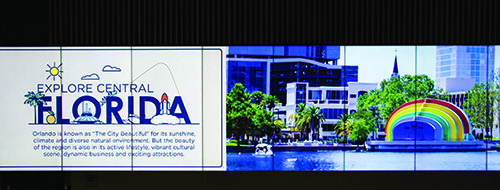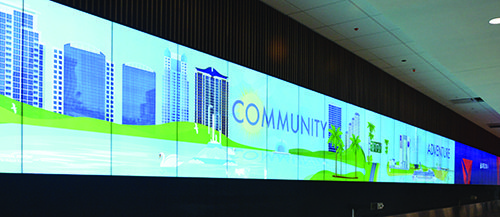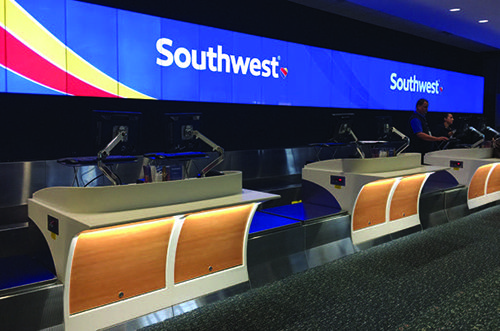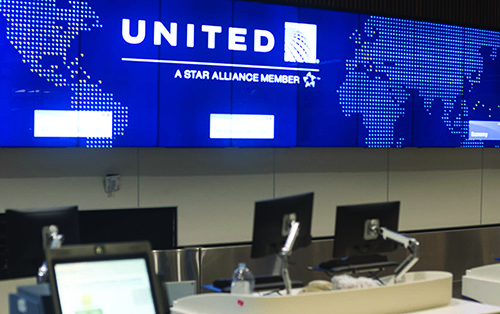When you hear the word “Orlando,” you probably think of vacation attractions: Disney World. Sea World. Beaches. Golf. Or perhaps you’ve attended an event at the Orange County Convention Center, the second-largest convention complex in the United States.
Given the area’s high concentration of tourists, conventioneers and business travelers, Orlando International (MCO) strives to create an experience unlike any other airport in the world. The Greater Orlando Airport Authority has even trademarked a name for it: The Orlando Experience(r). Last year, more than 42 million passengers “experienced” it.
In keeping with its own customer service standards and those set by local attractions, MCO is installing a giant video wall behind the check-in counters of its North Terminal that displays airline branding and flight information that changes according to traffic. When airlines are not using specific sections, the airport runs videos and a children’s game to entertain visitors.
As of late July, MCO had completed more than half of the wall; crews are expected to finish the remaining portion by the end of the year. Total cost for the project is estimated at less than $10 million.
When installation is complete, the new digital feature will span about the length of five football fields.
The Wow Factor

Authority execs found inspiration for the huge installation in 2015, when traveling to the Asia-Pacific region to scout emerging trends in airport technology and amenities. Chief Information Officer John Newsome and Director of Engineering Mark Birkebak toured several airports and were particularly impressed by South Korea’s Incheon International Airport (ICN), which has been named the world’s best airport by Airports Council International for the last 12 years.
Impressed by the quantity and variety of video displays at ICN, Newsome was inspired to consider how MCO could leverage more video content. Back home, a major capital renovation of the main terminal was already under way-including a complete redevelopment of the check-in process.
“Renovating our ticket lobby to make check-in faster and more enjoyable for more passengers is a key component of our capital improvement plan,” Newsome explains. “Our economy depends on visitors having a good experience. Often, this is a trip people have dreamed of or planned for a long time, and we want to provide a ‘wow factor’.”
Two years after initial project planning, the “wow factor” the airport wanted is taking shape, in the form of a display that will ultimately contain more than 700 screens and stretch more than 1,500 feet.
 facts&figures facts&figuresProject: Video Wall Display Location: Orlando Int’l Airport Installation Site: Behind Check-in Counters Size: 1,500 ft. long Cost: Less than $10 million Installation Status: More than half complete in late July; remaining portion expected to be finished in late 2017 Software & Content Provider: Synect Project Management & Installation: SITA Com-Net Display Screens: 700+ Pixels/Screen: 6.2+ million Bezel Height: 1.8 mm Display Mfg: LG Electronics USA Content Management System: Cnario Digital Signage Software, from YCD Multimedia Custom Mounts: RP Visual Solutions Key Benefits: Flight info & airline branding can be changed quickly according to traffic; airport runs content to entertain customers on sections not in use by airlines Fun Fact: When complete, the video wall will be longer than the Empire State Building is tall |
“We wanted a fun and interactive check-in experience for passengers who travel to and from Orlando International Airport every year,” says Newsome. “It’s very easy to find your airline when the entire back wall is illuminated.”
Selecting a Supplier
In April 2016, the airport authority invited three major display vendors to present equipment options to the Construction Committee. To ensure objectivity, the authority hired an independent contractor to perform a battery of tests at its lab in Seattle. Each manufacturer set up a seven-screen, 55-inch long video wall, and all three options displayed the same content for evaluation. The lab even simulated natural light to mimic conditions at the airport.
With authority personnel on hand to observe, testers scored the various screens on a myriad of factors, including color depth, accuracy, and consistency; brightness range and variations; and ambient light reflection and absorption. Lab personnel also evaluated bezel width; heat generation and dissipation; monitoring functions, firmware updates and calibration; ease of installation and maintenance; failure prevention, responses and recovery; moisture, dust, heat and power protections; vendor support for installation, calibration, re-installation; and warranty terms and options.
LG Electronics USA ultimately won the contract to supply 1,126 screens.
“We had no idea going into the lab which company would be selected,” relates Newsome. “It was a very rigorous, very open process; and every piece of information was available to the competitors.”
All three contenders were also given the opportunity to review and comment on the process. “It was very above board and based on measurable factors,” he adds. “There were no protests.”
Thin Bezels, In-Plane Switching
Contrast ratio was a particularly important selection factor, because passengers must be able to view the screens from various angles and distances. As such, the authority chose units with in-plane switching, a technology for liquid crystal displays that resolves the limitations of the twisted nematic field effect matrix displays from the late 1980s-namely, limited viewing angles and low-quality color reproduction.

The new monitors also have ultra-thin bezels-1.8 millimeters, compared to the industry standard of 3.5 millimeters. Thinner bezels around the screens make the lines between the monitors barely discernible, even when viewed from just a few feet away. Although MCO’s display contains more than 700 monitors, it looks like one large, uninterrupted screen.
The hardware that supports the technologically advanced displays is also noteworthy-and was performance-tested in the lab as well. The mounting system opens out, like a door, to facilitate installation and removal. In addition, the displays are lighter than average, so they required two rather than three workers for installation.
Information & Entertainment

The airlines display information about specific services offered at each counter position, checkpoint wait times and even short videos. The screens are also fully integrated with the airport’s systems that provide flight information, gate assignments, destination time and weather, security information and dynamic wayfinding assistance.
When counters are not in use by an airline, the airport runs more whimsical content, including local tourism videos and a game called Find Fred the Fish. Much of MCO’s material is intended to engage and educate children about space and travel, a pervasive theme at the family-oriented airport. The content and the new video wall are designed to deliver the visual impact and entertainment value visitors have come to expect from the Orlando area, notes Newsome.
“Airports are starting to better brand their local community, and for us, the panels help do that,” he explains.
The Common-Use Factor
From the airlines’ perspective, the new digital canvas at MCO offers something that hasn’t been available before: large-scale dynamic branding in ticketing/check-in area. In the past, carriers may have felt that their branding didn’t begin until the gate.
“One reason some airlines have resisted common-use technology is that the counter space branding was not adequate,” observes Newsome. “Now, some of them are seeing the benefits of moving to common use, and this branding opportunity makes that pretty attractive. We can eliminate this barrier to common use, because now airlines can take their brand along anywhere they go.”

The airport’s intention is to make the check-in area as flexible as possible.
“We have a strong mix of passenger profiles, and large volumes of children and conventioneers,” says Newsome. “The way we use our ticket counters reflects the diversity and volume of our passengers.”
All of the counters are modular, with full connectivity and power. The baggage scales and service counters are of uniform width, which allows airlines to adjust quickly. Newsome notes that passenger processing technology is changing very rapidly, and the airport can reconfigure its check-in facility by moving counters on demand.
“The video wall is a perfect accompaniment to the modular counters,” he comments. “It brands each counter, and it’s all dynamic and can be changed to suit the airline as it evolves.”
The number of display panels each airline uses corresponds to how many counters it leases. British Airlines, for example, currently has counter space that equates to 22 panels. The minimum per airline is about 12 panels.
“The benefits to the airport are flexibility and helping us manage passenger numbers,” Newsome says. “The airlines get incredible branding opportunities they don’t get anywhere else in the world, and they can request an update at any time.”
Airlines design their own content, which is then submitted and reviewed by a committee to ensure it conforms with airport authority guidelines.
“In some areas, the panels are not reconfigured very often,” notes Newsome reports. “In common-use areas, we can go through changes three times a day-and it only takes about a minute to change it.”
Enhancing the Experience

Newsome reports that the airport’s new video wall has created a positive buzz among passengers and within the industry. “One of our four primary objectives is customer service, and we invest a great deal of money in innovation to give travelers a pleasant environment that is hopefully de-stressing and a little fun,” he says. “We see the airport as an extension of the resorts: We offer an extensive Wi-Fi system, a mobile app that provides turn-by-turn directions for 1,500 different locations (both voice and visual), and now we use enhanced digital displays to give passengers information in a way that is fun and pleasant.”
With crews still finishing the giant installation, some of the video wall’s features have yet to be activated. “There is much more to come,” notes Newsome.
Beyond the remaining portion of the video wall, future projects will include outdoor digital displays, self-service check-in screens and wayfinding video walls.



